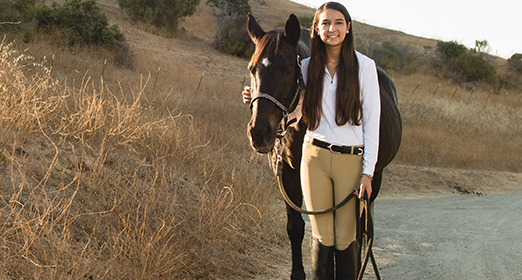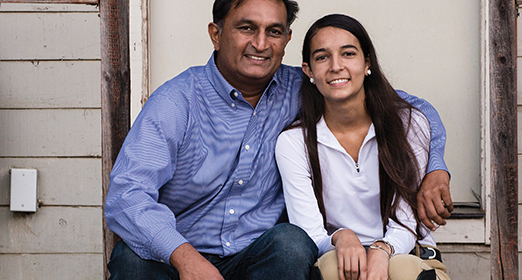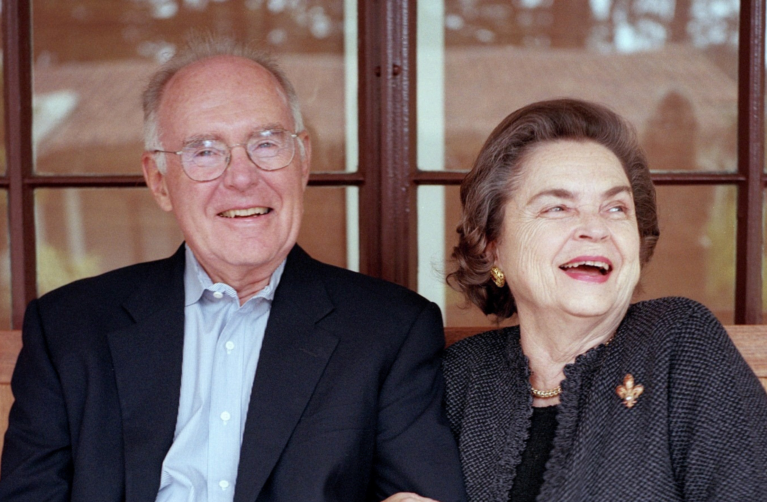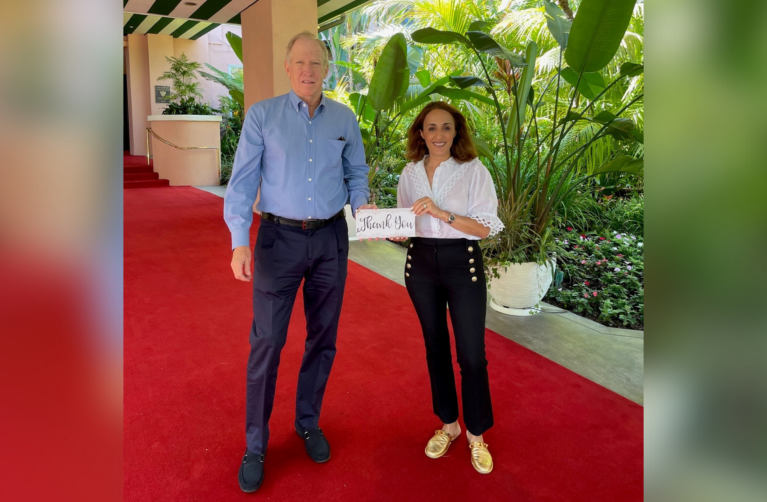What happens when a 25-year veteran pediatric cardiologist suddenly finds himself with an unexpected new patient—his own daughter?
Earlier this year, 15-year-old Maya Desai, an accomplished high school student and equestrian from Los Altos, who had led a normal, healthy life, began complaining of fatigue, chest pain, and heart palpitations. Her father, Kavin Desai, MD, lead pediatric cardiologist for Kaiser Permanente Northern California, initially chalked it up to growing pains.
But one evening after work, he was worried enough to hold a stethoscope to Maya’s chest. After several late-night tests at Kaiser Santa Clara, Desai diagnosed his own daughter with a congenital abnormality of her mitral valve. Her mitral valve, the gate between the left atrium and the left ventricle of the heart, was opening but not closing properly, leading to so much valve leakage that her heart had to work three to five times harder to get enough blood to Maya’s body.
She needed open-heart surgery—the sooner the better.
As a Stanford-trained pediatric cardiologist who still holds a clinical appointment at Lucile Packard Children’s Hospital Stanford, Desai says his choice for his daughter’s operation was easy: he wanted Frank Hanley, MD, executive director of the Children’s Heart Center and one of the nation’s top pediatric cardiothoracic surgeons, to perform the operation. On August 7, Maya underwent the four-hour surgery at our hospital.
In a Q&A eight weeks after her surgery, Desai and Maya talk about the strangeness of suddenly having their relationship change from father-daughter to doctor-patient, and how Hanley and the Children’s Heart Center at Lucile Packard Children’s Hospital Stanford made all the difference in the world.
Q: As the chair of Kaiser Permanente’s pediatric cardiology group, was it unorthodox for you to have Maya’s heart surgery performed at Lucile Packard Children’s Hospital Stanford?
Desai: Kaiser Permanente doesn’t perform pediatric heart surgeries, so we refer all of our patients who need surgeries to other institutions. It is not unusual to send our patients to Lucile Packard Children’s Hospital Stanford. I have an active relationship with Stanford—I’m on the faculty and still see patients and teach medical students, residents, and fellows there.
I very quickly decided that I wanted to be Maya’s father, not her doctor, so I called in a colleague from Kaiser to handle other preliminary cardiac tests. And Dr. Hanley was my choice for her surgeon, as I felt that he provided the best opportunity to salvage my daughter’s heart valve. There are not a lot of pediatric heart surgeons, especially if you want to stay relatively local, and the fact that there is a person of his caliber right here was a “no brainer.”
People ask me all the time whether I was in the operating room with Maya. I stayed in the waiting room like any other parent. When you have a surgeon with your daughter’s heart literally in his hands, you don’t want anything to distract him.
Q: What were the biggest decisions and issues you had to face?
Desai: We knew we had to do something quickly, as Maya’s valve was deteriorating rapidly and she was becoming more and more symptomatic. We had to decide whether to repair the valve or replace it with a mechanical one. If we replaced it, Maya would have to be on blood thinners, which would have major implications on her life. A future pregnancy would be difficult if not impossible, and her favorite pastime, horseback riding (she competes in dressage), would be off limits. So our first choice was for a repair. With Dr. Hanley’s expertise, he was able to do that.
Maya: The scariest part was thinking about what could go wrong: a stroke and the possibility of not waking up. But Dr. Hanley described the surgery as being as routine as getting gas for his car. His confidence made me feel more confident.
Q: How does this experience shape your view of Lucile Packard Children’s Hospital Stanford and your colleagues there?
Desai: I’ve known and respected Dr. Hanley as a friend and colleague for a long time. But being in the position of the protective parent was different. I’m really happy with the care he gave my daughter.
Successful surgical outcomes also depend on outstanding contributions of the many other caregivers who are part of the care team. I will always be grateful to all the excellent physicians, nurses, and staff in the operating room, CVICU, and pediatric ward who provided such professional and attentive care to my daughter and my family.
Q: You also helped found Camp Taylor, a series of summer camps here in California for children with heart disease and their families. In hindsight, how did your family’s participation in the camp help prepare both of you for Maya’s diagnosis?
Desai: Ordinarily, physicians get to spend about 30 minutes in an appointment with their patients. We don’t get to know them very well that way. But spending a week with them at camp, you become part of a giant family of heart patients. You get to see the other side and hear the patients’ stories about what it’s like to live with heart disease—the entire journey from diagnosis and treatment to getting married and living life.
Living 15 years with a healthy daughter and then suddenly finding out that she too has congenital heart disease—it was a very strange thing for me. Now I had skin in the game. But knowing these other children and their families and seeing how they’ve come through it helps.
Maya: I went to the camp with my parents when I was younger, but when I got older I stopped going because I didn’t feel like I fit in. I didn’t know I had heart disease at the time. Looking back on it now, knowing some of those kids made my journey less scary. A lot of them are going to college and doing normal things.
Q: Did being a cardiologist and a cardiologist’s daughter make the process easier? How does this change your perspective for the future?
Desai: It was a double-edged sword. It was terrible knowing everything that could go wrong, which I didn’t share with my family. And because I’m a cardiologist, everything working up to the surgery was streamlined. Everything happened so fast we didn’t have time to process it as a family.
On the other hand, after doing this for 20 years, you’re able to put things in perspective. You know just what to expect and how to prepare your child for it.
Maya: It was great having parents [her mom, Julie, is a former nurse] who could explain everything to me. Any question I had, they could answer. And my dad and doctors encouraged me to be active after the surgery. I’m already back to riding horses, playing my violin, and riding my bike up a pretty steep hill to school.
Desai: As for the future, this made me part of the club. I’m no longer the cardiologist looking from the outside in. I know what it’s like to walk in the shoes of a parent of a child with heart disease. Now I can tell my patients and their families that I really do know what they’re going through.
This article first appeared in the Fall 2015 issue of Lucile Packard Children's News.




